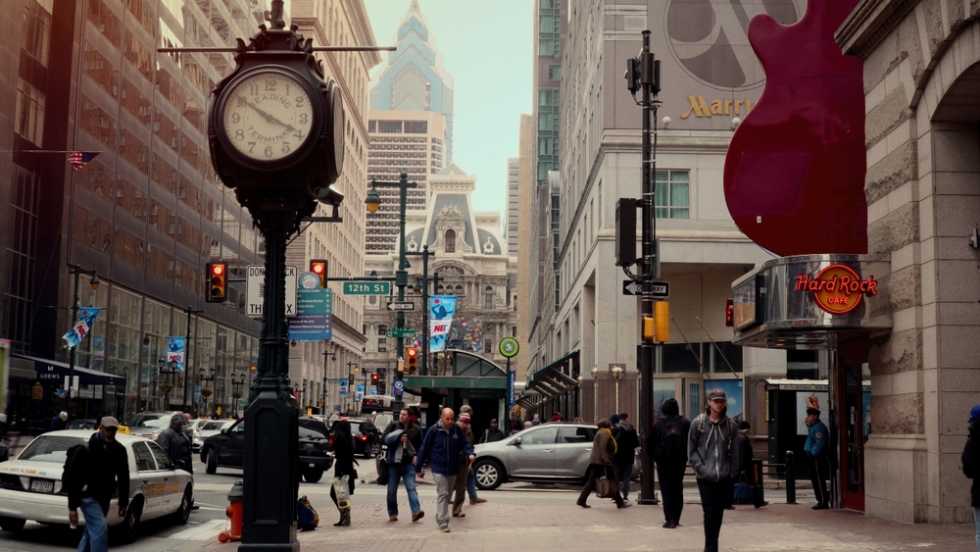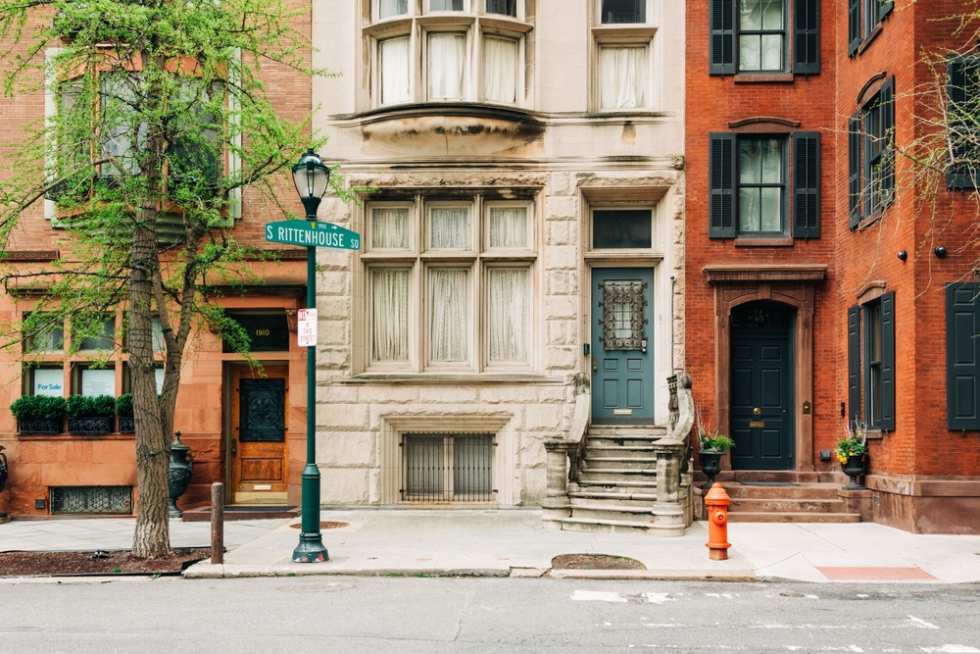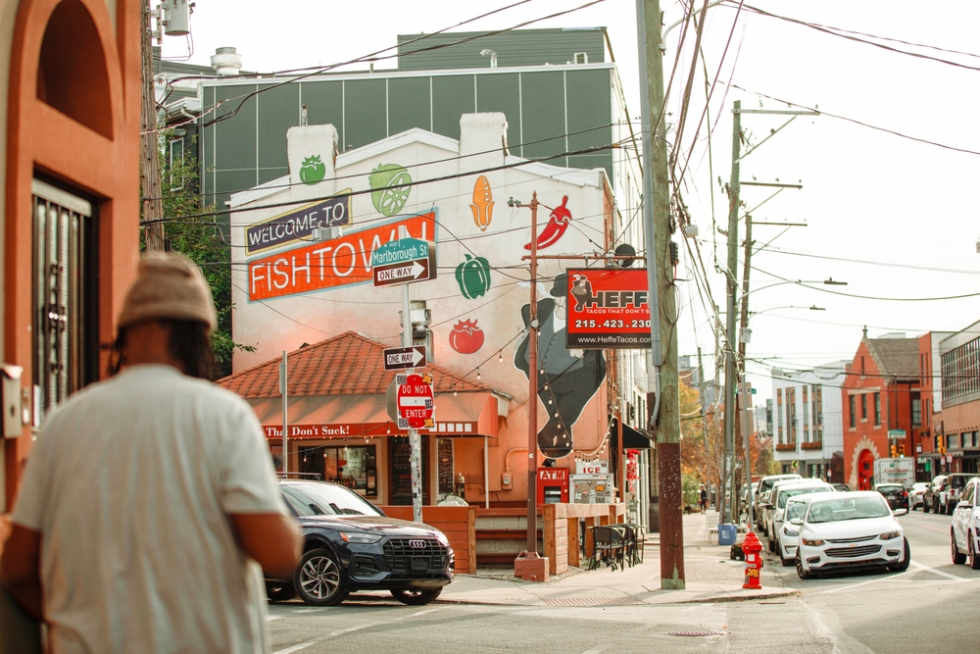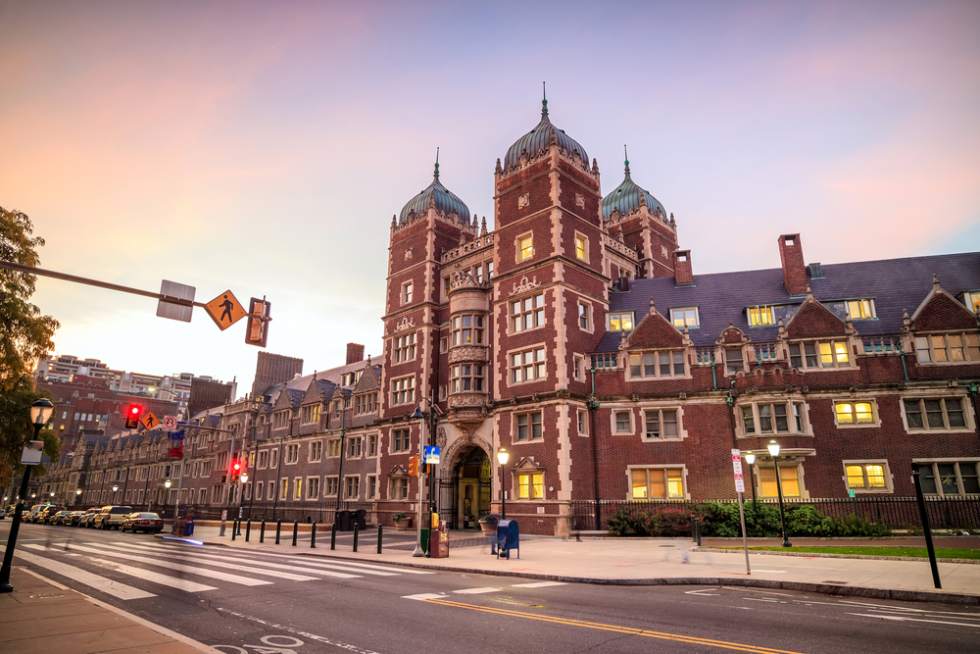One Thousand One
- 114 units available
- Studio • 1 bed • 2 bed • 3 bed
- Amenities
In unit laundry, Patio / balcony, Hardwood floors, Dishwasher, Pet friendly, Garage + more

Philadelphia earns a walk score of 75, placing it firmly among the most pedestrian-friendly cities in the U.S. From historic cobblestone corridors to bustling commercial streets, Philly’s neighborhoods are built for walkers, with transit stops, daily errands, and local favorites often just a few blocks away.
With rents on the rise and car costs adding up, choosing a walkable neighborhood isn’t just about lifestyle. It’s a smart budget move. Walkable areas often mean you can ditch the car, save on insurance and gas, and spend more time exploring your neighborhood instead of sitting in traffic. And in Philly, you’ve got plenty of options.
This guide covers nine of the best walkable neighborhoods in Philadelphia: from food-lovers’ Passyunk Square to ivy-lined University City to other hidden gems where you can live well without wheels.
Use this 2025 guide to find a neighborhood where errands, entertainment, and essentials are all a short stroll away.

Walkable neighborhoods make life in Philadelphia easier, cheaper, and more enjoyable. With grocery stores, coffee shops, parks, and SEPTA stops close by, walkable living cuts down on commute time and car expenses, two of the biggest line items in any renter’s budget. In a city like Philly, where parking can be tight and gas prices unpredictable, walking is a smart way to live.
Beyond convenience, walkable areas also foster stronger community connections. Sidewalk cafés, block events, and casual run-ins with neighbors help renters feel more rooted. And whether you're heading to class, commuting to Center City, or grabbing dinner on foot, a high walk score often signals better access to everything that makes city life enjoyable.
Living in a walkable Philadelphia neighborhood can save renters thousands each year, literally. According to AAA, skipping car ownership saves the average person more than $12,000 annually on gas, insurance, maintenance, and parking. That’s money that can go toward rent, groceries, or just enjoying the city.
And the benefits go beyond your wallet. Boston University reports that people in walkable areas are 1.5 times more likely to engage in adequate levels of physical activity, which helps reduce the risk of chronic disease and supports mental health. Environmentally, fewer cars on the road means fewer emissions—about 4.6 metric tons of CO₂ per vehicle per year, according to the U.S. Environmental Protection Agency.
Walk score is a zero to 100 rating that estimates how easily residents can accomplish daily tasks on foot—think errands, dining, and commuting. With a 2025 walk score of 75, Philadelphia ranks as one of the most walkable cities in the U.S., particularly in its core neighborhoods.
Here’s how the city stacks up overall:
| Metric | Score |
|---|---|
| Walk score | 75 |
| Transit score | 67 |
| Bike score | 67 |
In 2025 and 2026, SEPTA is rolling out major upgrades that will make the city even easier to navigate without a car. Projects include trolley modernization (with low-floor, ADA-accessible vehicles), a $200M overhaul of City Hall Station, and new real-time tracking apps for subways and buses.
These improvements are expected to boost transit reliability, reduce delays, and make even more neighborhoods walk-and-ride friendly for renters across the city.
To determine the most walkable Philadelphia neighborhoods for renters in 2025, we used the following datasets:
We also cross-referenced real-time neighborhood profiles and upcoming infrastructure plans to ensure recommendations are relevant.
To qualify for our list, each neighborhood had to meet the following minimum thresholds:
Each neighborhood was then evaluated using this weighted system:
| Neighborhood | Walk Score | Average One-Bedroom Rent | Nearest SEPTA Stops | Violent Crime Grade |
|---|---|---|---|---|
| Rittenhouse Square | 99 | $2,080 | 19th Street light rail station, 16th/15th Street metro station (PATCO Line), and Suburban Station (regional rail) | Above average |
| Center City West | 99 | $2,790 | Suburban Station (regional rail), City Hall metro station (Broad Street Line), William H. Gray III 30th Station, and 19th Street light rail station | Above average |
| Bella Vista-Southwark | 97 | $1,500 | 19th Street light rail station, Suburban Station (regional rail), and 10th/9th Street metro station (PATCO Line) | Above average |
| Fishtown | 94 | $1,723 | Girard metro station (Market-Frankford Line) | Above average |
| South Philadelphia East | 91 | $1,348 | Pattison metro station and Oregon metro station (Broad Street Line) | Above average |
| Fairmount | 91 | $1,649 | Fairmount metro station (Broad Street Line) and Suburban Station (regional rail) | Above average |
| University City | 90 | $2,810 | 30th Street metro station (Market-Frankford Line), Penn Medicine Station (regional rail) | Above average |
| Point Breeze | 89 | $1,306 | Tasker Morris metro station (Broad Street Line) and Ellsworth-Federal metro station (Broad Street Line) | Above average |
| Haverford North | 83 | $1,546 | Haverford Avenue and 44th Street bus station and Haverford Avenue and 46th Street bus station | Above average |
Rittenhouse Square ranks high for renters looking to live where everything is just a few steps away. Known for its namesake park, boutique shopping, upscale dining, and cultural events, it’s the kind of place where errands, date nights, and morning jogs all happen within a few blocks. The weekend farmers market, cozy bookstores, and café patios draw a steady stream of foot traffic.
This area is great for young professionals, couples without cars, and anyone who works remotely and thrives on city energy. Suburban Station makes regional commuting seamless. One drawback? Rent isn’t cheap, and parking is nearly nonexistent, but walkable apartments here offer value through proximity to amenities and a high-quality lifestyle.

Center City West delivers high-end walkability with seamless access to SEPTA transit, upscale dining, and major employers. Just steps from Rittenhouse Square and the business district, it’s ideal for renters who want premium perks without relying on a car. You’ll find everything from national retailers and gourmet markets to landmark cultural venues within a few blocks.
This neighborhood suits executives, law clerks, and remote workers who prize walkable apartments in a polished setting. Proximity to Suburban Station and 30th Street Station also makes it an ideal location for regional commuters. The biggest drawback is that rents here are among the highest in the city, and parking is both scarce and expensive. But if you want luxury and walkability rolled into one, Center City West is hard to top.
Bella Vista-Southwark is one of Philly’s most character-rich neighborhoods, with walkable apartments tucked between Italian bakeries, corner bars, and family-owned eateries. It’s home to the famous 9th Street Italian Market and close to Queen Village and South Street for extra entertainment.
Renters who prioritize local flavor and a sense of community (think artists, graduate students, and longtime city dwellers) will appreciate the lively yet livable pace. You can walk to multiple grocery stores, green spaces, and SEPTA stops. The only downside is occasional weekend foot traffic and the limited availability of large apartment buildings, which means options fill up quickly.
Fishtown blends creative energy with walkable access to the city’s best food and music. Popular with freelancers and young professionals, this northeast neighborhood is packed with breweries, vinyl shops, tattoo parlors, and converted loft apartments. North Front Street serves as the commercial spine, featuring vintage stores and indie cafés. The Market-Frankford Line makes commuting downtown quick.
Rent here has climbed in recent years, so newcomers might pay more than in nearby Kensington. Street parking is tight, but walkability and public transit access help you skip the car altogether.

South Philly East scores for renters who want quiet streets, grocery stores within walking distance, and easy subway access. The area borders Passyunk Square and has seen an increase in foot traffic thanks to its vibrant food scene and proximity to big-box stores.
Perfect for renters looking to ditch the car without sacrificing daily essentials, this neighborhood suits families, retirees, and couples on a budget. The Broad Street Line makes Center City commutes a breeze. Be prepared for smaller units in older buildings, though, and less nightlife than in neighboring areas.
Fairmount draws renters with its museum district, wide sidewalks, and residential feel. You’ll be within walking distance of the Philadelphia Museum of Art, Whole Foods, and scenic running trails along Kelly Drive. Brownstone walkups and low-rise apartments add to the charm.
This is an excellent fit for city-loving renters who also appreciate parks, pets, and a more relaxed pace. Families, remote workers, and longtime locals love its steady rhythm. Rents are moderate by Center City standards, but parking and transit options can be limited, depending on your exact block.
University City is one of Philly’s best neighborhoods for car-free living, thanks to world-class transit and a dense grid of shops, cafés, and campus buildings. Home to the University of Pennsylvania and Drexel University, it’s packed with students, researchers, and healthcare professionals.
Walkable apartments near the Schuylkill River and Spruce Street make getting to classes, hospitals, and downtown simple. Rent is steep, especially near the UPenn campus, and families may find the student energy less appealing. But for academics and renters craving top-tier transit access, it’s hard to beat.

Point Breeze mixes old-school row homes with new construction, making it a magnet for first-time renters and city newcomers. The area has gained walkable cafés, yoga studios, and grocery options in recent years while maintaining a down-to-earth atmosphere.
Remote workers and budget-conscious renters who want proximity to Center City without the prices will appreciate Point Breeze’s appeal. SEPTA buses and bike lanes help offset the lack of a subway stops. As the area gentrifies, expect construction and uneven blocks, but the value remains.
Haverford North may not get the same buzz as Fishtown or University City, but it’s gaining traction thanks to its quieter streets, low-rise apartments, and walkable access to West Philly institutions. It’s right between Fairmount Park and Drexel’s fringe.
This neighborhood suits renters who want a local feel and affordable, walkable apartments without constant crowds. SEPTA bus and trolley access help with daily errands, and small parks dot the area. It’s still an up-and-coming neighborhood, so expect occasional upkeep issues or limited nightlife, but it’s a smart pick for those who want walkability and room to grow.
In Philadelphia, most rental listings hit the market between May and July, when demand is high and competition can be fierce. If you're looking for better deals and more negotiating power, consider apartment hunting between December and February, when many landlords are eager to fill units.
Set custom rent alerts on Apartment List with your max budget, desired amenities, and move-in window, and opt in for text or email updates so you can act fast when something matches.
In walkable, high-demand neighborhoods, speed and preparation matter. Have a digital renter’s packet ready to send within two hours of any tour. This should include:
If you have pets or roommates, include documentation such as vaccination records or combined income summaries to streamline the approval process.
While rent prices are often nonnegotiable in high-demand areas, there’s still wiggle room. Offer to sign an 18- to 24-month lease to potentially shave 3% to 5% off the monthly price. If the rent is firm, ask about concessions, a free month of parking, waived pet fees, or access to bike storage.
When negotiating, back up your offer with walk score comparisons, amenity lists, and competing listings to support your position. Landlords are more likely to engage when you demonstrate that you’ve done your research.
If you're looking for affordability and walkability, Point Breeze and South Philadelphia East are standout picks. Both post walk scores over 85 and currently list one-bedroom apartments under $1,400, well below the citywide average.
Many apartments in highly walkable neighborhoods like Fairmount and Bella Vista are pet-friendly, but terms vary. Always double-check for breed restrictions, pet deposits, and monthly pet rent before signing your lease.
While safety can vary from block to block, neighborhoods like University City, Fairmount, and South Philadelphia East have lower-than-average violent crime rates according to recent data. Stick to well-lit streets and know your route if walking after dark.
In denser neighborhoods like Rittenhouse Square or Fishtown, garage parking can cost $200 to $350 per month, and street parking is competitive. Areas like Haverford North and Point Breeze tend to have more residential street parking, but permits may still be required.
SEPTA’s trolley modernization and upgrades to City Hall Station are expected to improve pedestrian flow and public transit access citywide. Additionally, major projects like the Penn’s Landing Park cap could turn car-centric corridors into pedestrian-friendly zones by 2026.

In unit laundry, Patio / balcony, Hardwood floors, Dishwasher, Pet friendly, Garage + more
In unit laundry, Pet friendly, Garage, Stainless steel, 24hr gym, Pool + more